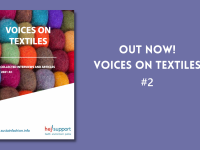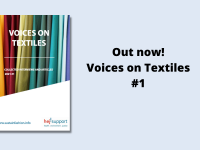The Health Effects of Polyester

Polyester is the most commonly used fiber in the world, accounting for over 50% of global fiber production volume in 2019.1 Despite its popularity, polyester has the potential to cause many potential adverse health effects, both directly through human exposure and indirectly through the environment.
There are several chemicals involved in the production of polyester. Antimony trioxide, used as a catalyst in production, has been postulated to cause cancer in humans, and this raises an urgent cause for concern to address its direct impact on health.2
Additionally, the majority of human health effects in relation to polyester manufacturing and use are a result of indirect exposure through various environmental routes. During the dyeing process, a significant amount of contaminated discharge is directed into untreated wastewater which ends up in local water and groundwater systems, adversely impacting the health of local communities and residents.3
One of the most significant issues associated with polyester as well as many other plastic-derived fibers is microplastic shedding. Microplastics have several pathways by which humans can be directly exposed, such as inhalation, ingestion and dermal contact.4 A common route for microplastic shedding into water sources in particular includes the discharge from laundry washing machines, which causes further contamination of seas and oceans as well as the food chain.2 There have been instances of foods as diverse as beer, salt, honey and sugar which have been found to contain microplastics.2
There is a dearth of information regarding these pathways affecting human health and the specific disease implications.4 Known effects of exposure to microplastics include potential oxidative stress and inflammatory lesions as well as chronic inflammation and heightened risk of neoplasia due to the limited capability of the immune system to clear these synthetic foreign bodies.4
All in all, it is important to protect both human health and the environment to the greatest extent possible, and a push for the transition away from plastics and creating sustainable polyester alternatives is a must.
References
- Opperskalski, S., Siew, S., Tan, E., & Truscott, L. (2020). Preferred fiber & materials market report 2020. Textile Exchange. Retrieved from: https://textileexchange.org/wp-content/uploads/2020/06/Textile-Exchange_Preferred-Fiber-Material-Market-Report_2020.pdf
- Ellen MacArthur Foundation. (2017). A new textiles economy: Redesigning fashion’s future. Retrieved from: https://www.ellenmacarthurfoundation.org/assets/downloads/publications/A-New-Textiles-Economy_Full-Report_Updated_1-12-17.pdf
- Bick, R., Halsey, E., & Ekenga, C.C. (2018). The global environmental injustice of fast fashion. Environmental Health, 17. Retrieved from: https://link.springer.com/article/10.1186/s12940-018-0433-7
- Prata, J.C., da Costa, J.P., Lopes, I., Duarte, A.C., & Rocha-Santos, T. (2020). Environmental exposure to microplastics: An overview on possible human health effects. Science of the Total Environment, 702(1). Retrieved from: https://www.sciencedirect.com/science/article/abs/pii/S0048969719344468






